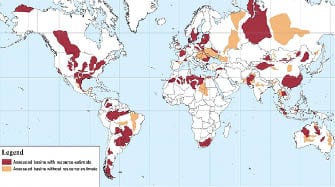EIA: Non-Shale Gas Resources Add Significantly to Recoverable Global Estimates
An updated estimate of technically recoverable global shale gas resources by the U.S. Energy Information Administration (EIA) puts them at 7,299 trillion cubic feet (tcf)—10% higher than estimated in 2011. The June-released World Shale Gas Resources: An Initial Assessment of 14 Regions Outside the United States surveys at least nine new countries and double the number basins (95) and formations (137) and adds about 47% to the 15,583 tcf of proved and unproven non-shale technically recoverable natural gas resources previously estimated (Figure 5). Globally, 32% of the total estimated natural gas resources are in shale formations, while 10% of estimated oil resources are in shale or tight formations, the EIA concludes.
According to the assessment, China leads the world with an estimated 1,115 tcf of technically recoverable shale gas resources, followed by Argentina and Algeria. The U.S. is fourth with 665 tcf, Canada is fifth with 573 tcf, and Mexico is sixth with 545 tcf. Expressed interest or exploration activities have begun in shale formations in a number of other countries, including Algeria, Argentina, Australia, China, India, Mexico, Poland, Romania, Russia, Saudi Arabia, Turkey, Ukraine, and the UK, the report says.
 |
| 5. Growing shale oil and gas estimates. In a new assessment, the U.S. Energy Information Administration (EIA) estimates the world’s shale gas resources are 10% higher than previously thought. This May 2013 map shows the global basins assessed. Red areas represent basins assessed as having technically recoverable resources while tan areas show basins assessed that had no recoverable resources. Source: EIA |
Tight oil and shale gas resources have “revolutionized” U.S. oil and natural gas production, the EIA notes, providing 29% of total U.S. crude oil production and 40% of total U.S. natural gas production in 2012. “However, given the variation across the world’s shale formations in both geology and above-the-ground conditions, the extent to which global technically recoverable shale resources will prove to be economically recoverable is not yet clear,” the agency says.
The market effect of shale resources outside the U.S. is expected to depend on their own production costs, volumes, and wellhead prices. “For example, a potential shale well that costs twice as much and produces half the output of a typical U.S. well would be unlikely to back out current supply sources of oil or natural gas. In many cases, even significantly smaller differences in costs, well productivity, or both can make the difference between a resource that is a market game changer and one that is economically irrelevant at current market prices.”
More work remains to be done, the EIA says, however, noting that the assessment does not include prospective shale gas formations underlying large oil fields in the Middle East and the Caspian region.
—Sonal Patel is POWER’s senior writer.